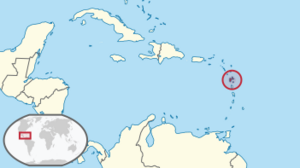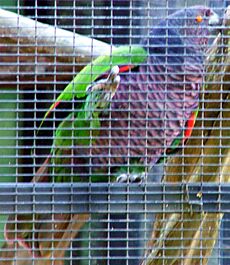Guadeloupe amazon facts for kids
Quick facts for kids Guadeloupe amazon |
|
|---|---|
 |
|
| Du Tertre's 1667 illustration showing three Guadeloupe amazons (8) and one Lesser Antillean macaw (7) on a tree at the left | |
| Conservation status | |
| Scientific classification | |
| Genus: |
Amazona
|
| Species: |
violacea
|
 |
|
| Location of Guadeloupe | |
| Synonyms | |
|
List
Psittacus violaceus Gmelin, 1788
Chrysotis violaceus (Rothschild, 1905) Amazona violaceas (Rothschild, 1905) Amazona violaceus (Rothschild, 1907) Anodorhynchus purpurascens (Rothschild, 1907) |
|
The Guadeloupe amazon or Guadeloupe parrot (Amazona violacea) was a type of parrot. It is believed to have lived only on the island of Guadeloupe in the Lesser Antillean region. People wrote about and described this parrot in the 1600s and 1700s. It was given its scientific name in 1789. Scientists think it was related to, or possibly the same as, the imperial amazon parrot, which still lives today. Some bones found on the island of Marie-Galante might belong to the Guadeloupe amazon. This parrot was rare by 1779 and seems to have become extinct by the end of the 1700s.
According to old descriptions, the Guadeloupe amazon had a head, neck, and belly that were mostly violet or gray. These colors were mixed with green and black. Its back was brownish green, and its wings were green, yellow, and red. The bird had shiny feathers and could raise a "ruff" of feathers around its neck. It ate fruits and nuts. Both the male and female parrots took turns sitting on their nest. French settlers hunted these birds for food and also destroyed their home.
Contents
Understanding the Guadeloupe Amazon
The Guadeloupe amazon was first described in 1664 by a French botanist named Jean-Baptiste Du Tertre. He also wrote about and drew the bird in 1667. Other writers, like Jean-Baptiste Labat, also described the bird later on. In 1789, a German naturalist named Johann Friedrich Gmelin gave the bird its scientific name, Psittacus violaceus. The name violaceus means "violet," referring to its color.

In 1905, a scientist named Austin Hobart Clark suggested that the Guadeloupe parrot was most closely related to the imperial amazon (Amazona imperialis). This parrot lives on the island of Dominica and has similar colors. Because of this, Clark placed the Guadeloupe bird in the same group, calling it Amazona violacea. The name Amazona comes from the French word for parrots found in the Amazonian rainforest.
Some scientists, like James Greenway in 1967, thought the Guadeloupe amazon might have been a type of the imperial amazon. They considered it a "hypothetical extinct species" because it was only known from old stories, not from actual bird remains.
In 2001, scientists Matthew Williams and David Steadman found a leg bone on Marie-Galante, an island near Guadeloupe. This bone was similar to that of the imperial amazon. They thought it might belong to the Guadeloupe amazon. Later, in 2015, other scientists suggested that an arm bone found on Marie-Galante also belonged to the Guadeloupe amazon.
The "Violet Macaw" Mystery
In 1905, a British zoologist named Walter Rothschild described a "violet macaw" that he believed lived on Guadeloupe. He based this on an old description of a deep violet parrot. He thought it was a type of macaw because it was entirely blue.
However, later research suggested this "violet macaw" was likely a mistake. Scientists now believe it was based on a confused description of the Guadeloupe amazon itself. For example, a dictionary from the 1600s described a "Guadeloupe variety" of parrot as "larger and violet, with red-lined wings." This description matches the Guadeloupe amazon, not a separate macaw species. So, it seems the "violet macaw" was not a real species, but a misunderstanding of the Guadeloupe amazon's description. The Lesser Antillean macaw was the only macaw species that lived on Guadeloupe.
What the Guadeloupe Amazon Looked Like
In 1654, Du Tertre described the Guadeloupe amazon:
The Parrot of Guadeloupe is almost as large as a chicken. Its beak and eye had a reddish border. All the feathers on its head, neck, and belly were violet, mixed with a little green and black. They changed color like a pigeon's throat. The upper part of its back was brownish green. Its long wing feathers were black, while others were yellow, green, and red. It also had two rose-colored spots on its wing-coverts.
Labat described the bird in 1742:
The Parrots of these islands are different from those on the mainland. Those from Guadeloupe are a little smaller than the Macaws. Their head, neck, and belly are gray, with some green and black feathers. The back is completely green, and the wings are green, yellow, and red.
Scientists noted that the shiny feathers described are not unique to the Guadeloupe amazon. Other fresh amazon parrots can also show this. The "ruff" of feathers around its neck, which it could raise when excited, is also seen in other amazon parrots.
Life and Habits
In 1664, Du Tertre wrote about the Guadeloupe amazon's behavior and what it ate:
When it raises the feathers on its neck, it makes a beautiful ruff around its head. It seems to admire this, like a peacock admires its tail. It has a loud voice, speaks very clearly, and learns quickly if caught young. It eats wild fruits from the forests, but not the manchioneel fruit. Cotton seeds make it feel dizzy, like wine affects a person. For this reason, they eat it with great eagerness... The taste of its meat is excellent, but it changes depending on what it eats. If it eats cashew nuts, the meat tastes like garlic. If it eats 'bois des inde', it tastes like cloves and cinnamon. If it eats bitter fruits, it becomes bitter. If it eats genips, the meat turns completely black, but it still tastes very good. When it eats guavas, it tastes its best, and then the French hunt many of them.
In 1667, Du Tertre also added details about how the parrots raised their young:
We had two that built their nest about a hundred paces from our house in a large tree. The male and female took turns sitting on the nest. They came one after the other to eat at the house, and brought their young when they were old enough to leave the nest.
Why the Guadeloupe Amazon Disappeared
In 1779, a scientist named Buffon said that the Guadeloupe amazon had become very rare. He explained why it might have become extinct:
We have never seen this parrot, and it is not found in Cayenne. It is even very rare in Guadeloupe today, as none of the island's people have given us any information about it. But that is not surprising, because since the islands have been settled, the number of parrots has greatly decreased. Du Tertre specifically noted that the French colonists hunted this one a lot during the season when it was especially fat and tasty.
Scientists believe that the Guadeloupe amazon was hunted for food by the people living on the island. Its home was also destroyed as more land was used for farming. Guadeloupe is not as mountainous as Dominica, where the related imperial amazon still lives. This made Guadeloupe more suitable for farming and led to more people living there. Because of this, the Guadeloupe amazon faced greater pressure and seems to have died out by the end of the 1700s. Today, all amazon parrot species still living on the West Indian islands are in danger. They are caught for the pet trade, overhunted for food, and their homes are still being destroyed.




